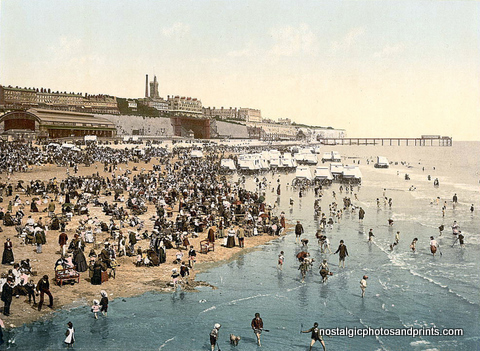Friday, 18 December 2009
Ramsgate
Ramsgate

Ramsgate began as a fishing and farming hamlet. Ramsgate as a name has its earliest reference as Hraefn's ate, or cliff gap, later to be rendered 'Ramisgate' or 'Remmesgate' around 1225 and 'Ramesgate' from 1357. The legendary mercenaries Hengest and Horsa landed in the 5th century to herald the pagan Anglo-Saxon age in England. The Christian missionary St. Augustine landed in Ramsgate in 597 which re-established the link between England and the Christian church in Rome.
Ramsgate's harbour is a defining characteristic of the town. The construction of Ramsgate Harbour began in 1749 and was completed in about 1850. The Harbour has the unique distinction of being the only Royal Harbour in the United Kingdom. Because of its proximity to mainland Europe, Ramsgate was a chief embarkation point both during the Napoleonic Wars and for the Dunkirk evacuation in 1940.
Ramsgate Sands in 1854In 1901, the Isle of Thanet saw the introduction of an electric tram service which was one of the few inter-urban tramways in Britain. The towns of Ramsgate, Margate and Broadstairs were linked by 11 miles of track.
In 1915-1916 early aircraft began to use the open farmlands at Manston as a site for emergency landings. The location near the Kent coast gave Manston some advantages over the other previously established aerodromes. By 1917 the Royal Flying Corps was well established and taking an active part in the defence of England. As RAF Manston the aerodrome played an important role in the second World War and is now called Kent International Airport.
http://en.wikipedia.org/wiki/Ramsgate

Ramsgate began as a fishing and farming hamlet. Ramsgate as a name has its earliest reference as Hraefn's ate, or cliff gap, later to be rendered 'Ramisgate' or 'Remmesgate' around 1225 and 'Ramesgate' from 1357. The legendary mercenaries Hengest and Horsa landed in the 5th century to herald the pagan Anglo-Saxon age in England. The Christian missionary St. Augustine landed in Ramsgate in 597 which re-established the link between England and the Christian church in Rome.
Ramsgate's harbour is a defining characteristic of the town. The construction of Ramsgate Harbour began in 1749 and was completed in about 1850. The Harbour has the unique distinction of being the only Royal Harbour in the United Kingdom. Because of its proximity to mainland Europe, Ramsgate was a chief embarkation point both during the Napoleonic Wars and for the Dunkirk evacuation in 1940.
Ramsgate Sands in 1854In 1901, the Isle of Thanet saw the introduction of an electric tram service which was one of the few inter-urban tramways in Britain. The towns of Ramsgate, Margate and Broadstairs were linked by 11 miles of track.
In 1915-1916 early aircraft began to use the open farmlands at Manston as a site for emergency landings. The location near the Kent coast gave Manston some advantages over the other previously established aerodromes. By 1917 the Royal Flying Corps was well established and taking an active part in the defence of England. As RAF Manston the aerodrome played an important role in the second World War and is now called Kent International Airport.
http://en.wikipedia.org/wiki/Ramsgate
Comments:
<< Home
Oh this is a terrific blog. I had to create a link straight away, many thanks.
http://melbourneblogger.blogspot.com/2009/12/beach-huts-in-australia-and-britain.html
Now I will go back and have a look at the other posts :)
http://melbourneblogger.blogspot.com/2009/12/beach-huts-in-australia-and-britain.html
Now I will go back and have a look at the other posts :)
Subscribe to Post Comments [Atom]
<< Home
Subscribe to Comments [Atom]

Post a Comment